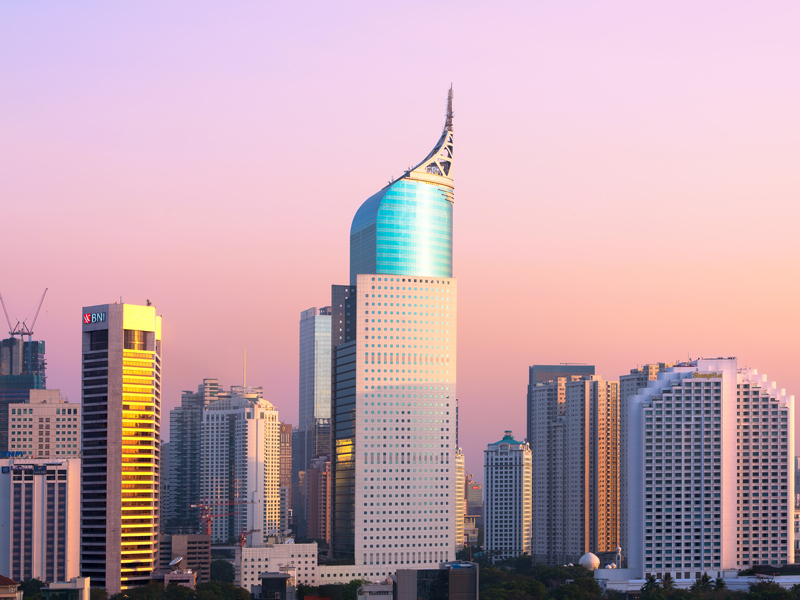Indonesia is the world’s fastest-growing e-commerce market
South-East Asia’s largest country is on the verge of a digital revolution thanks to its digitally savvy youth, the rise of tech start-ups and the promise of upcoming infrastructure projects

While Indonesia’s capital city, Jakarta, is densely populated, a significant proportion of the country lives in rural areas with limited access to consumer goods
With communities spread across 17,000 islands, Indonesia seems like an unlikely place for online shopping to take off. Although cities like Jakarta are densely populated, a significant proportion of the population lives in rural areas like Kalimantan, where they make a living from coal and palm oil. But delivering to these areas is costly, and makes e-commerce a logistical nightmare. Yet, in many ways, the fact that some Indonesians are so cut off from many consumer goods has created a growing appetite for online shopping. The country is now home to the fastest-growing e-commerce market in the world, according to PPRO Group, and is predicted to be worth $53bn by 2025.
The rise of e-commerce
The introduction of the smartphone to Indonesia was nothing short of revolutionary for the country. Unlike their Western counterparts, who typically went online for the first time via a computer, most Indonesians first experienced the internet through a mobile phone. Now, 95 percent of the country’s internet users are mobile and Indonesians spend 206 minutes a day on social media compared with the global average of 124. The launch of the mobile economy unlocked a wealth of opportunities for Indonesia’s consumers and fostered a growing demand for online shopping.
For more Indonesians to partake in the digital economy, the country will need to see an increase in its fibre optic network
Tokopedia is one of the most successful start-ups to emerge from this trend. Founded in 2009, the online marketplace arrived in perfect time to connect a growing base of online consumers with retailers and independent sellers. In 2017, the e-commerce platform won $1.1bn in investment from Chinese e-commerce giant Alibaba.
“When Tokopedia was established in 2009, Tokopedia saw the disparity in opportunities across Indonesia,” Nuraini Razak, Vice President of Corporate Communications at Tokopedia, told The New Economy. “Small businesses in rural areas have to move to urban areas to expand their market reach, while consumers across Indonesia have limited access to goods or have to pay more for the same goods just because of where they live.”
Platforms like Tokopedia have also facilitated the country’s burgeoning excitement for entrepreneurship. Traditionally, as one of the most resource-rich countries in the world, Indonesia’s labour force has been largely concentrated in the copper, tin, oil and gas industries or in Indonesia’s largest job provider, the agricultural sector. Now, the idea of starting an online business is gaining traction among the digitally savvy youth.
“Tokopedia enables more than 5.5 million merchants in Indonesia, 70 percent of whom consider themselves first-time entrepreneurs,” said Razak. “Increasingly, Indonesian users have options, convenience and financial access… [which,] further drive [the] Indonesian digital economy.”
Pushing for digital innovation
The Indonesian Government recognises the critical role that start-ups and SMEs have played in driving digital innovation within the country and has pledged to support the digitalisation of approximately eight million SMEs by 2020. There are also hopes that the country’s president, Joko Widodo, who was recently re-elected for a second term, will help to further the country’s digital transformation. In his last term, Widodo completed various infrastructure projects, building much-needed roads, railways and ports. Now he wants to continue to push infrastructure spending, both urban and digital.
Razak argues that the country has been steadily improving its internet penetration, citing “much cheaper smartphones and better network infrastructure, such as 4G/LTE”. However, unlocking true digital transformation will be no easy task for Widodo. According to McKinsey & Company, despite its digitally savvy citizens, Indonesia is well behind other ASEAN countries in the digital revolution. Bandwidth is poor compared with the rest of the region, and in some provinces, the proportion of people with access to the internet is as low as 2.5 percent.
For more Indonesians to partake in the digital economy, the country will need to see an increase in its fibre optic network, as well as enhancement of its 4G infrastructure. Fortunately, the Palapa Ring project will bring 13,000km of undersea fibre-optic cables to Indonesia’s major islands, while Teleglobal and SES Networks will improve internet access among remote areas with its satellite-based network.
Another key obstacle is the question of human capital. Currently, Indonesia lacks the tech talent needed to significantly drive growth. The country invests less than Singapore and Malaysia in education on a per capita basis, and highly skilled workers account for only 10 percent of total employment, according to the World Economic Forum. As a result, Indonesian companies often offshore tech work or bring in foreign advisors on a temporary basis.
Widodo aims to improve Indonesia’s education system and believes this change will depend partly on foreign investment. Indonesia has a free trade deal with Australia, which includes zero-tariff access on many goods and services for Australian universities to set up campuses in Indonesia. Widodo hopes that such moves will improve the transfer of skills from Australia to Indonesia.
Indonesia’s digital economy is poised to become the largest in South-East Asia. Already, e-commerce has had a transformative impact on the country, largely because of small businesses and start-ups driving innovation. Now, Indonesia needs to encourage and facilitate that innovation by implementing the right infrastructure and improving the education system. Only then can the country ensure that it truly reaps the benefits of digital transformation.













